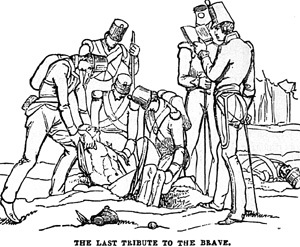
Corrections to "Disaster at Chalmette" from Benton Jennings.
I was glad to see Ian Fletcher's article "Disaster at Chalmette" in issue No.9, though I would like to point out a few errors which appeared concerning the Battle of New Orleans. Said errors are possibly attributable to the overzealous (naturally patriotic), if not sometimes misinformed, Park Rangers.
Firstly, the Royal Scots were not present, but rather the 21st Regiment Royal Scots Fusiliers. Not all regiments engaged were Peninsular veterans: the 93rd won Battle Honours in 1805 for the Cape of Good Hope and had remained there since, missing the action in Iberia. The pirate Jean Laffite was not present at the battle though a number of his men were, serving as artillery crews. Laffite was probably off somewhere counting his loot.
Jackson's rampart may have been in places higher than shoulder level as there are accounts from British officers stating they never saw the faces of the enemy, as the Americans would place their firearms over the top of the parapet and fire without exposing themselves. Such documentation also lends credit to the supposition that most of the British casualties came from the American artillery fire and not the overvaunted American marksmanship. As to the fascines and ladders, here we have one of the great "what if's"
Concerning the Battle of New Orleans. Due to the blunder of an officer of the 44th with a personal problem, the fascines and ladders were not picked up when they should have been before the assault. When the neglect was noticed and a detachment of the 44th sent back to retrieve the implements, the retrograde movement caused confusion in the attacking column. Though as one officer on the scene said that the scaling tools were not really needed - this was after all only a ditch and flotsam parapet, not a walled fortification - the psychological damage on soldiers expecting to have fascines was done. In fact the parapet was gained and even entered. One lieutenant of the 21st was inside and seeing the enemy running away turned to order his men forward only to find they had disappeared "as if the ground had swallowed them".
Major Dickenson of the 21st fell atop the rampart saying, "tell my commanding officer I died on your parapet". His body was returned by the Americans with full honours. On the British left along the river, Lt. Col. Rennie, also of the 21st, led forward a contingent of detached light companies, including that of the 93rd, stormed and took the advance redoubt, and even without the needed support from the column behind (which included the main body of the 93rd, being led off diagonally to support the faltering British right) proceeded to advance against the parapet Rennie too, dying atop the earthwork.
It must also be pointed out that Jackson's line continued on the other side of the river, the British launched a coinciding attack there and even with only one third of the detached force (the other had been carried too far down river in their boats during the crossing) the rampart was taken. The command under Col. Thornton advanced to 100 yards, fired and charged. The American defenders ran for two miles.
Included with captured paraphernalia were a cannon inscribed as being taken at Yorktown during the War of Independence (and now at Sandhurst) and an American Colour, which I am told hangs today in Whitehall. The arrival of and the unauthorized order of another British officer prevented the turning of the captured US guns on the flank of Jackson's parapet and resulted in the withdrawal of the victorious British from the position. Another great "what if?"
Packenham was also probably killed by artillery canister fire, rather than a sharpshooter, considering reports of his wounds, the simultaneous downing of two horses under him, and the statement of enemy fire "as of a great crash" immediately before he was hit the final time. There is recent speculation by some historians the river has not eroded away the left flank of the battlefield and what one sees today is much of what was there in 1814.
Annually at Chalmette Park the second weekend in January, there is a living history event commemorating the Battle with reenactors portraying both US and British forces. This event is not a battle reenactment, but in 1995 the adjacent community of Kenner hopes to sponsor just that on 35 acres of open land. As they say, watch this space.
Again, I was glad to see Mr. Fletcher's article on a battle which is often overlooked except for two versions of great epic cinema and very bad history: "The Buccaneer". We are all too aware of what films have done to history and the mistakes which must be corrected to an often gullible public.
Back to Napoleonic Notes and Queries #11 Table of Contents
Back to Age of Napoleon List of Issues
Back to MagWeb Master List of Magazines
© Copyright 1992 by Partizan Press.
This article appears in MagWeb (Magazine Web) on the Internet World Wide Web.
Other military history articles and gaming articles are available at http://www.magweb.com